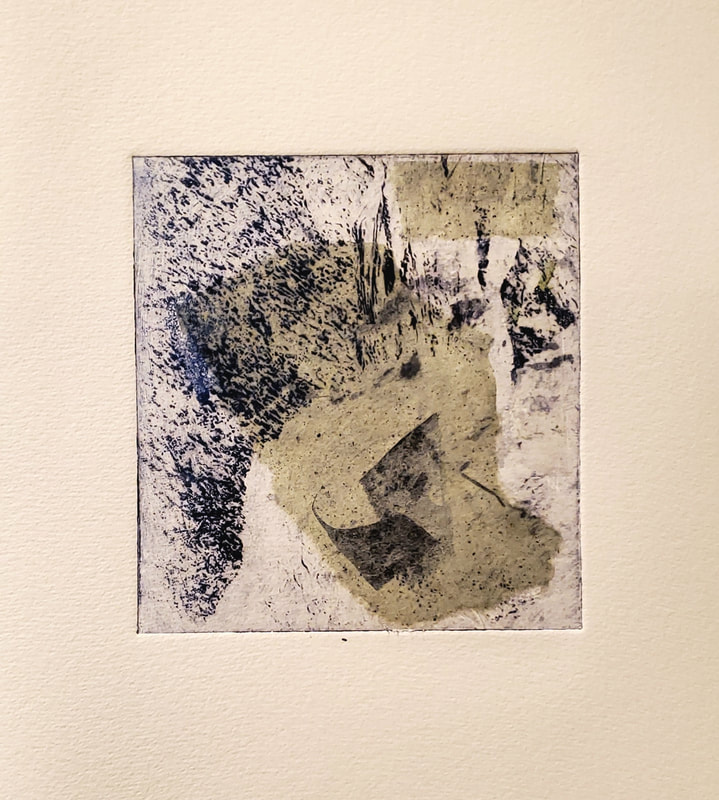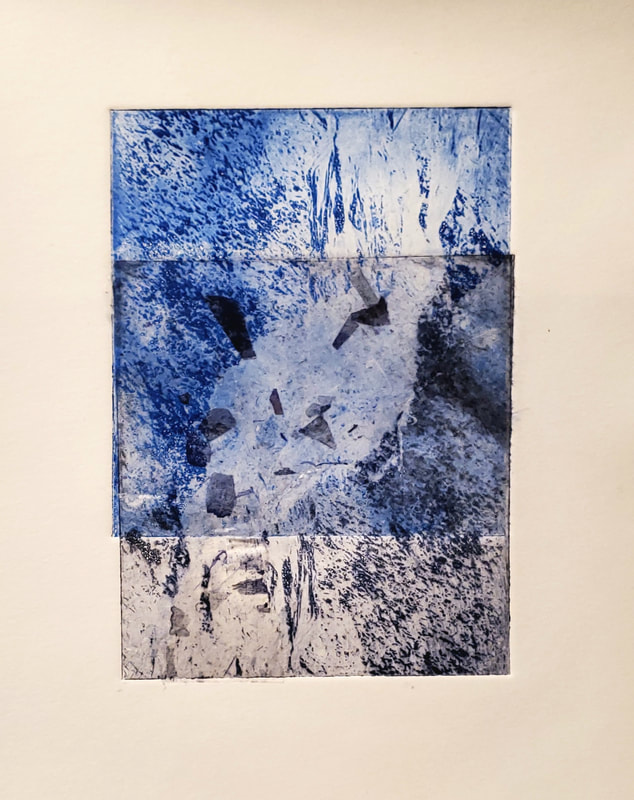|
This is a 5 x 8" solar plate processed with an aquatint screen and then an etching on acetate. It was printed with Akua black ink and a chin-colle mulberry strip. It seems that when an aquatint screen is used to process the plate, it picks up shadow and fine detail. You do not get a deep bite in the plate which makes including a relief over the intaglio inking a bit more challenging. As I rolled a relief color on the plate, I could see it picking up the black ink in the grooves, changing /muddying the relief [background] color a bit from it's original vibrant yellow to an ochre. Just an observation in the exploration, nothing wrong with ochre. Here I added a bit of phthalo blue to the yellow on the roller ink. I rolled the plate with blue akua ink, but then after past examples, I felt less ink would be a better outcome. The thick ink seemed very flat. On this blue piece, as an after thought, I used a crumpled sheet of newspaper to rub off some of the applied ink before pressing. I was extremely surprised and excited by the outcome. I loved the texture that was created in the paint. It appears to let in the light, allowing the white of the paper to peek through. Loving this outcome so much I decided to try and recreate this effect. I inked up the plate in red and the result of the process is below. Both are fabulous but I like the blue outcome better, probably because I over thought the red one . . . taking off paint everywhere instead of a few spots. But that is my humble opinion. It might have been the element of surprise that draws me to the blue one. Or perhaps it is because I am always drawn to blue . . . Ok, why not one last try - The Ghost Print I again used newspaper to remove ink, only being more mindful to leave the randomness of the texture and light. Notice the black ink is much lighter and chalky looking on this print. That is because it is a ghost print. A print that is pressed without reinking the plate, allowing the image to be much lighter and ghost like.  All comments, questions, thoughts and suggestions welcome.
Thank you for joining me on this artistic discovery journey. Wishing you all love and light!
2 Comments
Inspiration abounds when we are given the opportunity to participate in the artistic process. After seeing a talk / demo by master printmaker Dan Welden at Gallery 11 West, it resurrected my urge to get back to exploring the intaglio printmaking process. At a current CEEDs workshop with Dan and East End Arts workshop with ChrisAnn Ambrey, I created a few small solar plates that I have been working with. Here you will see a few different monoprints that all started with the same 4 x 5" plate. Intaglio, aquatint, chin-colle, additive and subtractive color . . . explore the process and embrace the results. You can never quite "see" what it will be until it is unveiled on the press. The print on the left is intaglio print with black ink. I did not get tremendous detail in the lower right circular area because I decided to process my etching screen without an aquatint process. I was interested in seeing what would happen. The aquatint would have allowed more of the shading detail to come through, without it only the darks and lights are very processed. But sometimes less is more. I have been having so much fun with this mighty and powerful little design. Second printing, I added a bit of color, used a brush to add circular detail and rubbed less ink off the plate before printing. These two monoprints include Chine-colle, including thin pieces of mulberry paper. These two are experiments with the inking process and imbedding different mulberry pieces. This example is the plate double pressed with an offset. Although this is interesting, there is so much I can see to change the outcome of this idea. One color, full offset, minimize the edge ink. I'm open to all suggestions. ALL COMMENTS WELCOME!
|
Archives
March 2024
|












